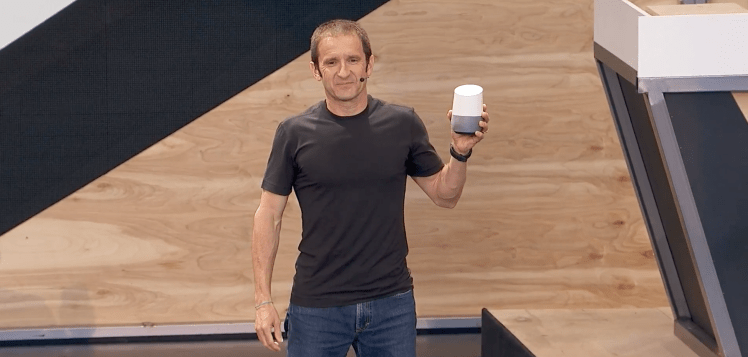Want smarter insights in your inbox? Sign up for our weekly newsletters to get only what matters to enterprise AI, data, and security leaders. Subscribe Now
At its Google I/O developer conference in Mountain View, California, Google today announced that it will be releasing a virtual assistant device called Google Home — later this year.
The technology looks sort of like Google’s OnHub router, introduced this year. But unlike OnHub, there will be no buttons, said Mario Queiroz, vice president of product management at Google. The system will be able to play music and podcasts using cloud services, but it will also uses Cast to work with different types of mobile devices, and it can even other play content on different speakers and television screens, Queiroz said. Various configurations will be available.
Google Home will be able to sync up with the most popular home networking systems, as well as Google’s own Nest devices, Queiroz said. But more generally, it can answer any question, thanks to the underlying Google Assistant technology that was introduced earlier today.

Above: Google Home.
Google did not disclose the price of the new gadget.
AI Scaling Hits Its Limits
Power caps, rising token costs, and inference delays are reshaping enterprise AI. Join our exclusive salon to discover how top teams are:
- Turning energy into a strategic advantage
- Architecting efficient inference for real throughput gains
- Unlocking competitive ROI with sustainable AI systems
Secure your spot to stay ahead: https://bit.ly/4mwGngO
The introduction of the product is not 100 percent surprising given recent rumors. Earlier this month Recode reported on the existence of Project Chirp, an initiative for launching an Amazon Echo competitor that resembled OnHub. And earlier this week the New York Times reported on a very similar type of product that carries the boldly expansive name Google Home, saying it would become available to consumers in the fall.
 But now that Google Home is real, not just a rumor, we can finally admit that Amazon made this market with its line of voice-activated assistants in the form of Bluetooth-enabled speakers. First came the $200 Echo. It didn’t have much of a precedent. It’s not omniscient — the underlying Alexa voice that talks back to you doesn’t know the answer to every question. And it forgoes the screen that people come to expect on nearly any piece of consumer electronics. But still, somehow, it caught on, and people haven’t stopped talking about it. Even financial analysts are curious about its potential.
But now that Google Home is real, not just a rumor, we can finally admit that Amazon made this market with its line of voice-activated assistants in the form of Bluetooth-enabled speakers. First came the $200 Echo. It didn’t have much of a precedent. It’s not omniscient — the underlying Alexa voice that talks back to you doesn’t know the answer to every question. And it forgoes the screen that people come to expect on nearly any piece of consumer electronics. But still, somehow, it caught on, and people haven’t stopped talking about it. Even financial analysts are curious about its potential.
And so Amazon doubled down. In March the company followed up the Echo with the release of the $130 Amazon Tap and the $90 Echo Dot. Now the company is going further to bring Alexa into the home — earlier this week Amazon revealed plans to incorporate Alexa voice commands into the Fire TV set-top box. Indeed, before asking Queiroz to come onstage and introduce Home, Google chief executive said, “Credit to the team at Amazon for creating a lot of excitement in this space.”
For Google, this is probably one of the most obvious products to come out with — the company just needed a sufficient reason to do it, like the runaway success of the Echo. Google already has the widely used Google Now assistant that supports voice queries and responses, and fairly well at that. Google has also demonstrated its interest in home audio market through the launch of the $35 Chromecast Audio device last year.


